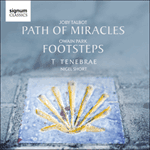
Welcome to Hyperion Records, a British classical label devoted to presenting high-quality recordings of music of all styles and from all periods from the twelfth century to the twenty-first.
Hyperion offers both CDs, and downloads in a number of formats. The site is also available in several languages.
Please use the dropdown buttons to set your preferred options, or use the checkbox to accept the defaults.


The insistent discords of the second movement reflect both the hardships of the road, keenly felt by this time after some initial euphoria in Roncesvalles, and the composer’s own sense of discomfort on visiting Burgos. The music trudges uneasily through this most awkward part of the journey, stopping regularly to recover breath and ease feet. There are stern warnings of human mischief and inhuman devilry, interspersed with musings on the mystical nature of the Saint’s translation. Robbery, lynching and illness are the least of a pilgrim’s problems; for just as the Saint can take the form of a pilgrim, so can the devil himself take the form of a Saint. As the laments and the warnings subside, the movement concludes with a line from Psalm 61, delivered in desolate, motionless tones from the lower voices: ‘A finibus terrae ad te clamavi’—From the end of the earth I cry to you.
Joby Talbot describes the third movement as a ‘Lux Aeterna’; and like the interior of the magnificent Cathedral of Leon, it is bathed in light. The journey is more than half complete, the pain barrier has been crossed and the pilgrim’s worries have indeed been sloughed off. A mediaeval French refrain, an ode to the sun in the key of C minor, punctuates simple observations of land traversed and hardships overcome. As with the previous movement, there is a steady, almost hypnotic walking pulse, but the steps have lost their heaviness. By the end of the movement the verses have arrived in the relative major, fused with the refrain which retains its original key. Mystical events are again spoken of, but this time with no sense of danger. Even the relentless sun, though it may dazzle, does not burn.
Meanwhile in Galicia the temperature cools, the altitude rises and the rain falls. Towns pass by like shadows as the road seems to climb and climb, though Leon’s contented mood lingers. There seems no doubt that the journey will end, and at the first sight of Santiago, miles down from the summit of Monte de Gozo, the music initially draws inward, before bursting out in an explosion of joy. The pilgrim’s hymn is heard again, performed with the reverence and reflection of one who has finished such a long journey, and is quickly transformed into a spring revel from the Carmina Burana.
Path of Miracles, like so many pilgrimages, does not finish in Santiago. The journey to Finisterre, to where the walls of heaven are thin as a curtain, has a reflective, epilogic tone, a benign hangover from the party in Santiago. Here the pilgrim’s hymn is heard for a final time, now in English, endlessly repeating and disappearing over the horizon.
from notes by Gabriel Crouch © 2006
 Park: Footsteps; Talbot: Path of Miracles Park: Footsteps; Talbot: Path of MiraclesThe first recording of Owain Park's 'Footsteps' is presented by way of a welcome bonus to a re-issue of Joby Talbot's 'Path of Miracles' as Tenebrae and Nigel Short celebrate fifteen years of exemplary performances.» More |

